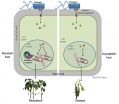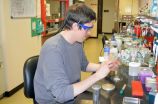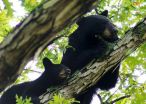Plant receptors with built-in decoys make pathogens betray themselves
Receptors carrying built-in decoys are the latest discovery in the evolutionary battle between plants and pathogens
2015-05-21
(Press-News.org) Receptors carrying built-in decoys are the latest discovery in the evolutionary battle between plants and pathogens. The decoy domains within the receptor detect pathogens and raise the cell's alarm when there is an infection.
Plants display component parts of their immune system on receptors to trick pathogens into binding with them, which then triggers defence mechanisms. The discovery comes from Professor Jonathan Jones' group at The Sainsbury Laboratory, published in the high-impact journal Cell with a companion paper on a similar discovery from the Deslandes group in Toulouse.
Pathogens target key parts of the plant's defence machinery in their attempt to suppress an immune response. Plants have evolved to display these targets on receptors that are primed to set off their alarm system. When the pathogen binds, the receptor starts the process of shutting down the cell to contain the pathogen and stop it from spreading.
The research from Professor Jones' group shows one way in which plants perceive pathogens. Perception of pathogens is essential for immunity. Plants have very efficient defence mechanisms to stop a pathogen, if they can detect it soon enough. In turn, pathogens are constantly evolving to become stealthier to evade perception by the host. This arms race means both plant and pathogen are constantly under pressure to evolve new ways to outwit each other. Scientists now know these ways include the integration of decoy domains within receptors.
The hypothesis that plants use decoys in this way was put forward last year. Professor Jones' study -- which appears with a companion study led by Laurent Deslandes at CNRS Toulouse -- is the first substantial evidence to support this theory.
Professor Jones hopes the group's discovery could lead to bioengineering new receptors carrying decoys to perceive and trigger a defence to virtually any pathogen. Before the group can make new receptors, they first have to understand their molecular architecture. The next step will be to recreate receptors with new decoys to act as targets for a disease against which a plant has no resistance.
The discovery means scientists can start developing the next generation of tools to equip plants with new defences to pathogens.
Professor Jones said: 'This is a very exciting discovery. It turns out as we survey the genomes of other plants we can see many more such "integrated decoy" domains associated with immune receptors, so we believe this observation will turn out to be of widespread significance. It's a great thrill to be involved in such important and interesting work. I am very grateful for the team of creative and dynamic students and postdocs in my lab whose dedication enabled these new insights.'
INFORMATION:
The project was funded by a Marie-Curie fellowship, the BBSRC, the Rural Development Administration (Korea) and the Gatsby Foundation (UK).
Notes to Editors
1. The paper 'A plant immune receptor detects pathogen effectors that target WRKY transcription factors' will be published in Cell on 21 May at 5pm GMT (12:00 EST).
2. The paper and images to accompany this press release are available at: http://bit.ly/1IKYKZP.
3. If you have any questions about the research or would like to interview Professor Jones please contact:
Geraldine Platten
Communications Manager
John Innes Centre & The Sainsbury Laboratory
t: 01603 450 238
e: geraldine.platten@jic.ac.uk
About The Sainsbury Laboratory (TSL)
The Sainsbury Laboratory (TSL) is a world-leading research centre focusing on making fundamental discoveries about plants and how they interact with microbes. TSL not only provides fundamental biological insights into plant-pathogen interactions, but is also delivering novel, genomics-based, solutions which will significantly reduce losses from major diseases of food crops, especially in developing countries. TSL is an independent charitable company and receives strategic funding from the Gatsby Charitable Foundation with the balance coming from competitive grants and contracts from a range of public and private bodies, including the European Union (EU), Biotechnology and Biological Sciences Research Council (BBSRC) and commercial and charitable organisations http://www.tsl.ac.uk
About the BBSRC
The Biotechnology and Biological Sciences Research Council (BBSRC) invests in world-class bioscience research and training on behalf of the UK public. Its aim is to further scientific knowledge, to promote economic growth, wealth and job creation and to improve quality of life in the UK and beyond.
Funded by Government, BBSRC invested over £484M in world-class bioscience in 2013-14.to supports research and training in universities and strategically funded institutes. BBSRC research and the people it funds are helping society to meet major challenges, including food security, green energy and healthier, longer lives. Research investments underpin important UK economic sectors, such as farming, food, industrial biotechnology and pharmaceuticals.
For more information about the BBSRC, its science and its impact see: http://www.bbsrc.ac.uk
About the Gatsby Foundation (UK)
Please see http://www.gatsby.org.uk/
About the Marie-Curie Fellowships from the European Commission
Please see http://ec.europa.eu/research/mariecurieactions/about-msca/actions/if/index_en.htm
About the Rural Development Administration (Korea)
Please see http://www.rda.go.kr/foreign/eng/
[Attachments] See images for this press release:

ELSE PRESS RELEASES FROM THIS DATE:
2015-05-21
Almost 90 per cent of men with advanced prostate cancer carry genetic mutations in their tumours that could be targeted by either existing or new cancer drugs, a landmark new study reveals.
Scientists in the UK and the US have created a comprehensive map of the genetic mutations within lethal prostate cancers that have spread around the body, in a paper being hailed as the disease's 'Rosetta Stone'.
Researchers say that doctors could now start testing for these 'clinically actionable' mutations and give patients with advanced prostate cancer existing drugs or drug combinations ...
2015-05-21
May 21, 2015 - A University of Wyoming faculty member led a research team that discovered a certain type of soil bacteria can use their social behavior of outer membrane exchange (OME) to repair damaged cells and improve the fitness of the bacteria population as a whole.
Daniel Wall, a UW associate professor in the Department of Molecular Biology, and others were able to show that damaged sustained by the outer membrane (OM) of a myxobacteria cell population was repaired by a healthy population using the process of OME. The research revealed that these social organisms ...
2015-05-21
When Dolphin was a typhoon on May 16, NASA's CloudSat satellite completed a stunning eye overpass of Typhoon Dolphin in the West Pacific at 0412 UTC (12:12 a.m. EDT). By May 22, Dolphin's remnants were moving through the Northern Pacific.
NASA's CloudSat satellite sends pulses of microwave energy through the clouds, and some of the energy in the pulses is reflected back to the spacecraft. The time delay between when the pulse is sent and when the reflected energy is received back at the spacecraft is mapped into a distance of the cloud from the surface of the Earth, and ...
2015-05-21
COLUMBIA, Mo. - Last year, researchers at the University of Missouri published a study on genetic diversity in American black bears in Missouri, Arkansas and Oklahoma and determined that conservation management is needed to maintain healthy populations in the region. Now, those scientists have expanded the study to include black bears throughout North America. They discovered that black bears in Alaska are more closely related to bears in the eastern regions of the U.S. and Canada than those located in western regions. Details from the study revealed ancient movement patterns ...
2015-05-21
(PARIS, FRANCE) - Stent thrombosis following urgent angioplasty for acute heart attack occurred in less than 1% of patients in a large, "real-world" registry, regardless of whether the antithrombotic treatment used during the procedure was bivalirudin, heparin alone, or a GP IIb/IIIa inhibitor (typically in combination with heparin).*
However, patients who experienced a stent thrombosis between days 2 and 30, regardless of drug regimen, were more likely to die within one year than were patients who developed stent thrombosis within the first 24 hours of their procedure.
"What ...
2015-05-21
Skin pliability and elasticity improved after treatment with onabotulinum toxin (Botox) for mild facial wrinkles and the effect lasted for up to four months, according to a report published online by JAMA Facial Plastic Surgery.
Human skin has three biomechanical features: strength, pliability (the ability to stretch) and elasticity (the ability to recoil). As people age, these properties change and the loss of skin elasticity appears to be the most prominent. Physicians use a variety of methods to reverse the signs of aging and onabotulinum toxin A injections are among ...
2015-05-21
Providing personalized education and risk assessment for patients with diabetes when they visit the ophthalmologist did not improve glycemic control as measured by hemoglobin A1c levels compared with patients who received usual care, according to a study published online by JAMA Ophthalmology.
Intensive blood glucose control can reduce the onset and progression of microvascular complications in people with diabetes. However, optimal glycemic control as measured by HbA1c is notoriously difficult to achieve. A potential strategy to improve glycemic control is to leverage ...
2015-05-21
A workplace intervention designed to reduce employees' work-family conflict and increase schedule flexibility also has a positive influence on the sleep patterns of the employees' children.
The intervention, Support-Transform-Achieve-Results (STAR), includes training supervisors to be more supportive of their employees' personal and family lives, changing the structure of work so that employees have more control over their work time, and changing the culture in the workplace so that colleagues are more supportive of each other's efforts to integrate their work and personal ...
2015-05-21
If a young man is a chronic gambler, the chances are extremely high that he also suffers from depression. This is one of the findings from a study led by Frédéric Dussault of the University of Quebec at Montreal in Canada. Published in Springer's Journal of Gambling Studies, it is the first to investigate the extent to which gambling and depression develop hand-in-hand from the teenage years to early adulthood.
Data were drawn from an ongoing long-term study that began in 1984. It follows a group of 1,162 kindergarten boys from economically disadvantaged areas ...
2015-05-21
PITTSBURGH, May 21, 2015 -- Exposure to fine particulate air pollution during pregnancy through the first two years of a child's life may be associated with an increased risk of the child developing autism spectrum disorder (ASD), a condition that affects one in 68 children, according to a University of Pittsburgh Graduate School of Public Health investigation of children in southwestern Pennsylvania.
The research is funded by The Heinz Endowments and published in the July edition of Environmental Research.
"Autism spectrum disorders are lifelong conditions for which ...
LAST 30 PRESS RELEASES:
[Press-News.org] Plant receptors with built-in decoys make pathogens betray themselves
Receptors carrying built-in decoys are the latest discovery in the evolutionary battle between plants and pathogens



